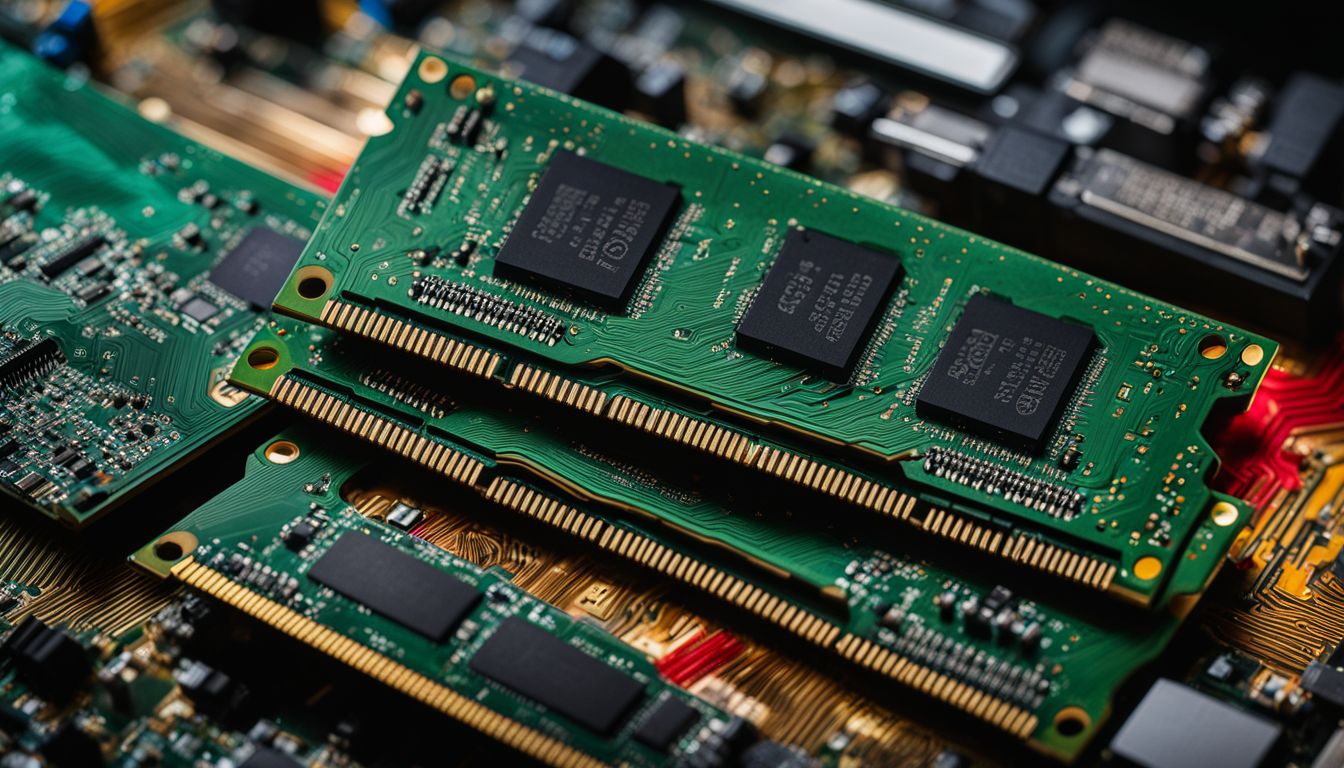DDR3 vs DDR4 RAM: Key Differences Explained

 DDR3 and DDR4 RAM are both types of memory used in computers, but they have some big differences. DDR RAM stands for Double Data Rate Random Access Memory. It’s a kind of memory that helps your computer run faster by letting it do more things at once.
DDR3 and DDR4 RAM are both types of memory used in computers, but they have some big differences. DDR RAM stands for Double Data Rate Random Access Memory. It’s a kind of memory that helps your computer run faster by letting it do more things at once.
Over time, this technology has gotten better, moving from older versions like DDR3 to newer ones like DDR4.
DDR4 RAM came out after DDR3 and brought along improvements. For example, while DDR4 has 288 pins and needs a voltage of only 1.20V to work, DDR3 uses 240 pins and runs on 1.50V. This change means that DDR4 is not only faster but also more power-efficient than its predecessor, making it better for both the environment and your electricity bill.
Even though they may look similar, you can’t use them interchangeably because their designs don’t match up.
Understanding these differences is key if you’re deciding between upgrading or buying new tech gear since the right choice can lead to better performance and savings on energy costs.
Keep reading to learn more about why choosing the right type of RAM matters for your computer setup!
What Is DDR RAM?
DDR RAM is a type of computer memory used for storing data that the CPU needs quick access to. It has evolved through generations, with each new version offering improved performance and efficiency.
Definition
DDR RAM stands for Double Data Rate Random Access Memory. This memory technology allows a computer to read and write data twice per cycle, speeding up the processing time. DDR RAM comes in different generations, each offering improvements over the previous one.
Each generation of DDR RAM has evolved with more pins and better performance. For example, DDR3 RAM modules use a 240-pin connector while DDR4 upgrades to a 288-pin connector. This change supports faster data transfer rates and improved efficiency in newer hardware setups.
Purpose
DDR RAM serves as the primary memory module for computers, providing swift data access. Its purpose is to enable random access memory (RAM) technology, which swiftly stores and retrieves data needed by the CPU.
As DDR generations evolve, their purpose remains consistent: enhancing data transfer rates and managing voltage requirements efficiently.
The evolution of DDR3 to DDR4 underpins its purpose in meeting everchanging technological demands. In the heart of the computer’s architecture, DDR RAM unlocks the secrets to improved performance and efficiency.
DDR RAM plays a pivotal role in enhancing system performance and efficiency.
Evolution through generations
DDR RAM has evolved through different generations, each with its unique characteristics and improvements. Here’s a detailed look at the evolution:
- DDR: Introduced in 2000 as DDR SDRAM (Double Data Rate Synchronous Dynamic Random-Access Memory), it doubled the data transfer rate compared to traditional SDRAM.
- DDR2: Released in 2003, it improved data transfer rates and reduced power consumption, utilizing a lower voltage of 1.8V compared to DDR’s 2.5V.
- DDR3: Debuted in 2007, offering higher transfer rates and reduced power usage further by operating at 1.5V.
- DDR4: Launched in 2014, it marked significant advancements with increased speed, greater capacity, and lower power consumption at just 1.2V.
- DDR5: Expected to enter the market soon, promising even higher speeds and efficiency for next-generation computing needs.
Each generation has built upon the previous one, delivering enhanced performance and efficiency tailored to evolving technological demands.
Differences Between DDR3 and DDR4 RAM
DDR3 and DDR4 RAM differ in pin layout, voltage requirements, and interface type.
Pin layout
DDR3 RAM uses a 240-pin connector, while DDR4 RAM utilizes a 288-pin connector. This difference in pin layout affects compatibility and prevents interchangeability between the two memory generations.
Additionally, DDR4 SO-DIMMS have 260 pins, surpassing the 204 pins seen in DDR3’s configuration.
Voltage requirements
DDR4 RAM operates on a lower voltage of 1.20V, while DDR3 RAM requires 1.50V to function efficiently. The reduced power consumption of DDR4 contributes to better energy efficiency and less heat generation, making it an attractive option for those seeking improved performance with lower power usage.
When comparing the voltage requirements between DDR3 and DDR4 RAM, it’s important to note that the decreased operating voltage in DDR4 not only enhances its energy efficiency but also aligns with modern green computing initiatives.
This transition reflects an advancement in memory technology towards more sustainable and eco-friendly solutions, supporting the global effort to reduce energy consumption in electronic devices.
Interface type
DDR3 RAM uses a 240-pin connector, while DDR4 RAM uses a 288-pin connector. The difference in pin configuration directly impacts their compatibility with motherboards and overall performance.
It’s important to consider the interface type when choosing between DDR3 and DDR4 RAM modules for your system setup.
Backward compatibility
DDR3 RAM is backward compatible with older RAM generations, allowing it to work in motherboards designed for DDR2 or even DDR1. However, this is not the case for DDR4 RAM due to its different pin layout and voltage requirements.
This means that systems using DDR4 memory cannot support older generation RAM modules, limiting the upgrade options for users with existing hardware configurations.
Performance Comparison
DDR4 RAM boasts higher data transfer rates and operates at lower voltages compared to DDR3, leading to improved performance and energy efficiency. This difference is crucial in determining the overall speed and power consumption of your system’s memory modules.
Data transfer rates
DDR4 RAM boasts significantly higher data transfer rates compared to DDR3. With DDR4, the peak data transfer rate is 17 GB/s per channel. In contrast, DDR3 typically has a maximum data transfer rate of around 14.9 GB/s per channel.
This enhanced speed of DDR4 allows for improved overall system performance and quicker data access.
The higher data transfer rates of DDR4 also contribute to better multitasking capabilities and seamless handling of large files. These faster rates make DDR4 an appealing choice for users seeking enhanced computing experiences and smoother operation across various applications and tasks.
Operating voltage
DDR4 RAM operates at a lower voltage of 1.20V, while DDR3 RAM requires 1.50V to function. This difference in operating voltage contributes to the improved power efficiency and performance capabilities of DDR4 over DDR3, making it an essential consideration when choosing between the two RAM technologies.
The lower operating voltage of DDR4 not only reduces power consumption but also facilitates higher data transfer rates, enhancing overall system performance. Embracing this newer technology can significantly benefit users seeking faster and more energy-efficient computing experiences.
Refresh rates
DDR4 RAM has a faster refresh rate than DDR3, which contributes to its higher performance. The faster refresh rates allow for quicker access to data, resulting in improved overall system speed and responsiveness.
DDR3 RAM, on the other hand, has lower refresh rates compared to DDR4. This ultimately affects the data transfer speed and operational efficiency of the memory modules. Understanding these differences is crucial when evaluating the performance capabilities of DDR3 versus DDR4 RAM.
Moving on to “Performance Comparison”…
Advantages of DDR4 over DDR3
DDR4 offers higher speeds, improved power efficiency, and greater capacity. These enhancements lead to significant performance boosts in various computing tasks.
Higher speeds
DDR4 RAM offers higher speeds compared to DDR3, with data transfer rates that can reach up to 3200 MT/s. This increased speed allows for quicker access to stored data and more efficient processing, making DDR4 particularly suitable for demanding tasks such as gaming, video editing, and multitasking.
The enhanced speed of DDR4 also contributes to improved overall system performance, providing a noticeable difference in responsiveness and loading times.
The higher speeds of DDR4 are attributed to its improved architecture and optimized design for faster operation. With data rates per cycle being four times that of DDR3, the higher speeds enable smoother execution of complex applications and enhance the user experience across various computing activities.
Notably, this boost in speed aligns with the evolving demands of modern software and applications that require rapid access to memory resources for seamless functionality.
By embracing these advanced speeds offered by DDR4 RAM, users can experience heightened efficiency and productivity in their computing endeavors – an essential consideration when seeking optimal performance from their systems.
Better power efficiency
Moving from discussing the higher speeds of DDR4 to its better power efficiency, it’s important to note that DDR4 RAM operates at a lower voltage of 1.20V compared to DDR3’s 1.50V requirement.
This reduced operating voltage significantly contributes to better power efficiency, leading to less energy consumption and heat generation while maintaining high performance levels.
Furthermore, the improved power efficiency of DDR4 RAM aligns with modern energy-saving initiatives, making it a more sustainable choice for computing needs. With these advantages in mind, considering the better power efficiency aspect becomes crucial when evaluating the overall benefits of upgrading to DDR4 RAM technology over DDR3.
Higher capacity
Moving from better power efficiency to higher capacity, DDR4 RAM also offers greater memory capacity compared to DDR3. This means that DDR4 allows for larger memory modules, enabling more data to be stored and accessed at faster speeds.
With this higher capacity, users can experience improved multitasking capabilities and enhanced performance in applications requiring substantial memory resources.
DDR4’s increased capacity provides a significant advantage over DDR3 in meeting the demands of modern computing tasks and applications. The ability to accommodate larger memory capacities makes DDR4 an ideal choice for users seeking improved overall system performance, especially in environments with heavy workloads or intensive computational needs.
Factors to Consider When Choosing Between DDR3 and DDR4
Consider motherboard compatibility, budget constraints and intended use for optimal performance. To learn more about DDR3 vs DDR4 RAM, read the full blog!
Compatibility with motherboard
When considering DDR3 and DDR4 RAM, the compatibility with the motherboard is a crucial factor. DDR4 RAM offers higher speeds, power efficiency, and capacity; however, it is important to note that not all motherboards support DDR4.
When choosing between DDR3 and DDR4, one must meticulously verify their motherboard’s specifications to ensure compatibility with the desired RAM type. Additionally, consider any potential future upgrades or system enhancements to tailor your choice of RAM towards an ever-evolving computing environment.
Moving on from Compatibility with Motherboard – let’s delve into discussing “Budget” as another significant factor when deciding between DDR3 and DDR4 RAM.
Budget
When considering the budget for RAM, it’s essential to note that DDR4 modules may come with a higher price tag compared to DDR3 due to its newer technology and enhanced performance.
However, as DDR4 becomes more widespread, costs are gradually aligning with its predecessor. It’s crucial to factor in the long-term benefits of investing in DDR4, including improved efficiency and higher capacity while evaluating the short-term impact on your budget.
Newer generations of RAM often carry a premium at their initial release but can offer better future-proofing and overall system performance. It’s important to weigh these considerations against your immediate budget constraints when making a decision between DDR3 and DDR4 RAM options.
Purpose of use
When choosing between DDR3 and DDR4 RAM, it’s essential to consider the purpose of use. If you require a memory upgrade for a newer system build or if you engage in demanding tasks like video editing, gaming, or 3D rendering, DDR4 with its higher speeds and capacity may be the better choice for improved overall performance.
Conversely, if you’re working with an older motherboard that does not support DDR4 or are on a tighter budget, DDR3 could still serve your needs effectively.
Ultimately, the purpose of use should dictate which RAM type best suits your requirements. Whether it’s maximizing speed and efficiency for intensive applications or ensuring compatibility with existing hardware and cost-effectiveness, understanding the specific demands of your usage will guide the decision between DDR3 and DDR4 RAM.
Conclusion
In conclusion, deciding between DDR3 and DDR4 RAM involves considering pin layout, voltage requirements, interface type, and backward compatibility. DDR4 offers higher speeds, better power efficiency, and greater capacity compared to DDR3.
When choosing between the two types of RAM, ensure compatibility with your motherboard and consider your budget and intended use. Remember that DDR4 surpasses DDR3 in performance and efficiency while striving for simplicity and practicality.
Embracing the potential impact of these differences can lead to substantial improvements in system speed and responsiveness. Explore further resources to deepen your understanding of RAM technology’s impact on overall system performance.
Take action now to upgrade your system’s memory for a smoother computing experience!
FAQs
1. What is the main difference between DDR3 and DDR4 RAM?
The key difference between DDR3 and DDR4 RAM lies in their speed and efficiency; DDR4 offers faster speeds and is more power-efficient than DDR3.
2. Can I use DDR4 RAM on a device designed for DDR3?
No, devices designed for DDR3 cannot use DDR4 RAM because they have different pin configurations and operate at different voltages.
3. Why is DDR4 considered better than DDR3?
DDR4 is considered better because it processes data quicker, uses less power, making your computer run faster and more efficiently.
4. Will upgrading from DDR3 to DDR4 improve my computer’s performance?
Yes, upgrading from DDR3 to DDR4 can improve your computer’s performance by increasing its speed and efficiency during tasks that require random access memory.





